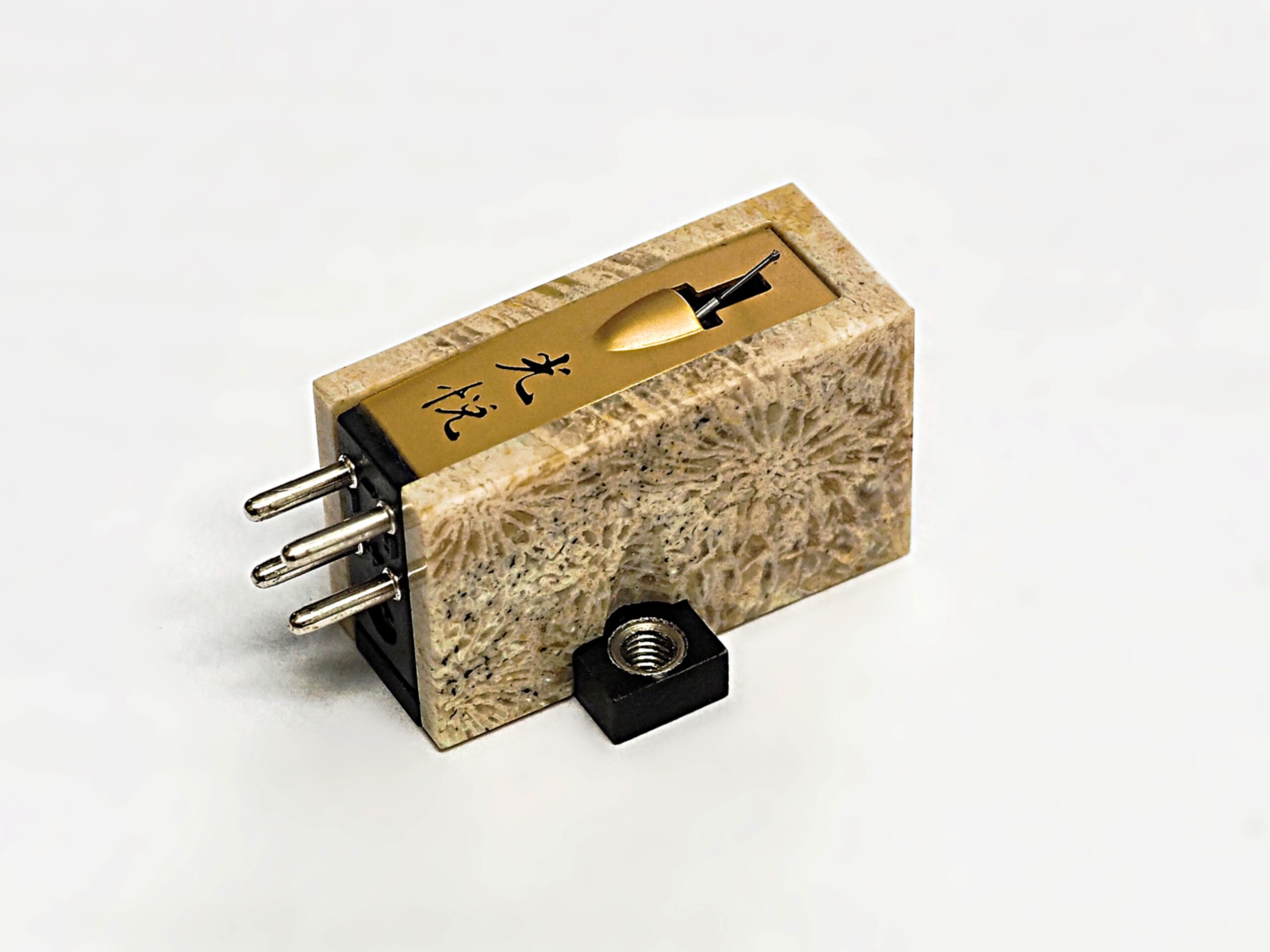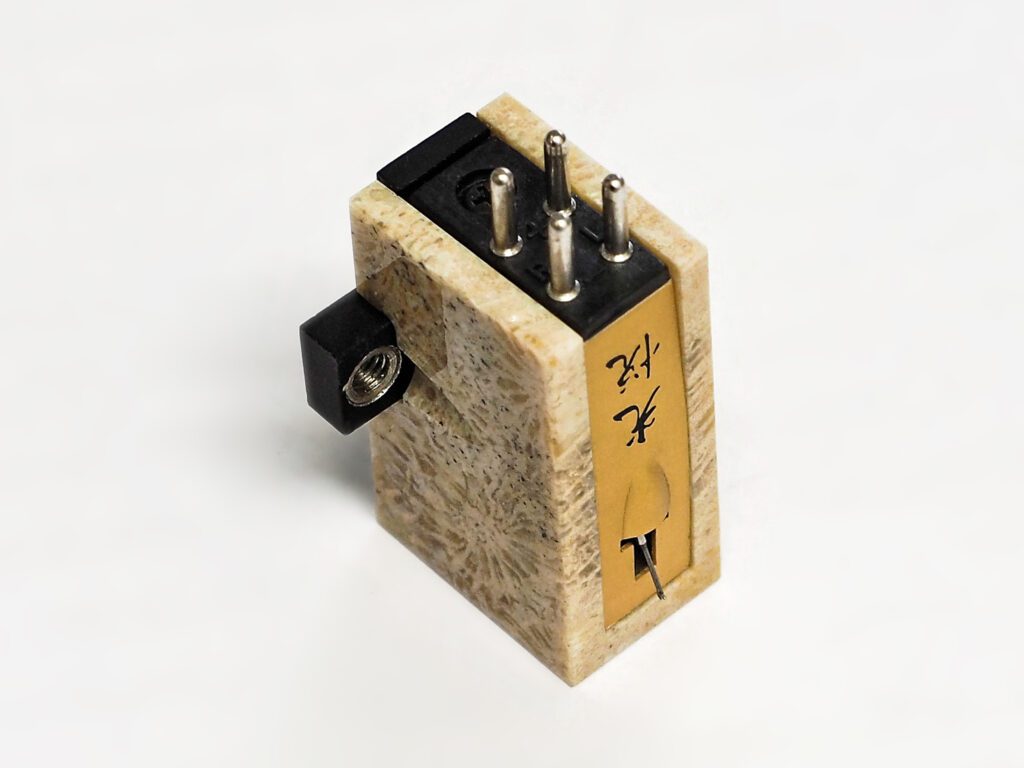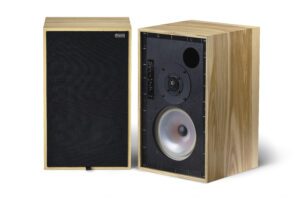
When it comes to iconic hi-fi brands, Koetsu is among the elite. Audio Royalty no less. The company, founded by Yoshiaki Sugano, produces exquisite moving coil cartridges that have a near-mythic reputation for quality. Coralstone is a beautiful example of Koetsu artisanship.
Coralstone is very much an upper-echelon Koetsu, retailing at £8,498. Despite the hefty price tag, it’s by no means the most expensive model in the Koetsu family. However, it is undoubtedly among the most beautiful, thanks to its gorgeous gemstone body.
A glance at the printed specifications of assorted Koetsu cartridges indicates more similarities than differences between the various models. Coralstone has a cantilever made from boron, and coils wound from silver-plated copper, with an impedance of 5 Ohms. It weighs 12.5g.
The power of platinum
The generator uses a platinum magnet – an alloy of the cobalt-platinum system, and one of the most powerful permanent magnet materials known. It can be machined, rolled, or drawn without difficulty, and lends itself to the creation of magnets with complex shapes or very small sizes.
The diamond tip is a proprietary fine-line type designed by Sugano-San and manufactured by Ogura. A classic magnetic circuit is used with a traditional Yoke. Still, due to the use of a platinum magnet, the output drops slightly to 0.3mV compared to 0.4mV for Koetsu’s using neodymium magnets.
The gemstone body, specially chosen for its beauty and natural grain, is carved from solid stone and polished to a gloss finish. It looks more like a piece of jewellery than an audio component! The somewhat ‘blocky’ squared-off nature of the body is very much Koetsu’s signature shape…
It’s easily been a decade or more since I last had a Koetsu cartridge at home. Would the wait be worth it? Fortunately, Coralstone did not disappoint. Its sonic presentation was outstandingly cohesive and very detailed, yet noticeably more neutral and natural-sounding than expected.
I now seek truthfulness and neutrality from vinyl replay. I want to feel I’m listening to the original master tape, rather than a flawed piece of vinyl with lots of fake character added. The sound should be clean and detailed, with no background noise as far as possible. Not much to ask for!
I fitted the Coralstone to an Origin Live Resolution turntable with an Illustrious arm and set the tracking weight to the suggested upper limit of 2g. Early impressions were of a very natural open tonality that sounded clear, unobtrusively detailed, and deceptively unexaggerated.
Jumpin’ with a Shuffle
One of the first LPs I played was Jumpin with a Shuffle by the Jonah Jones Quartet on Capitol – an excellent French-pressed reissue of the original 1960 USA LP. In some ways, Capitol’s Full Dimensional Stereo recording appears not that ambitious in terms of range – the sound is slightly contained. Or is it?
I used to think this LP was no more than average but played on a suitable turntable/arm/cartridge, the recording opens out. The crisp breathy tones of Jonah Jones’ muted trumpet solos cut like a hot knife through butter. And Jones’ crooning vocals are smooth, yet focused and present.
Coralstone reproduced this LP with unexaggerated naturalness, while at the same time bringing out contrasts I hadn’t realised were there. For example, the trumpet solos were suddenly showing much more significant presence and projection than usual.
Playing the Contemporary Records album West Side Story with Andre Previn and his Pals – the Mo-Fi pressing – the sound was crisp and very detailed. The cutting level on this LP is a tad on the low side, so a good pickup is needed to tease out all the detail – which the Coralstone most assuredly did.
Using a Pro-Ject Phono-Box RS2 as my phono stage, I set the gain to maximum and chose a capacitance of 200pf and a loading resistance of 600 Ohms. These settings were not ultra-critical but seemed to deliver an excellent overall result.
In particular, Red Mitchell’s bass line seemed slightly cleaner and firmer at 200pf compared to higher capacitance values, while Previn’s piano sparkled and sang. As ever, in another system, with a different tonal balance, an alternative set of values might be preferred.
Power and depth
Turning to the album Bass Desires by Marc Johnson on ECM, I was impressed by the sheer weight and heft of reproduction – the power and depth of the lower frequencies. The sound was solid and cohesive, unobtrusively detailed and rich.
Mine’s just a standard ECM German pressing on normal vinyl, but – based on what I was hearing – the LP almost sounded like an audiophile remaster at 45rpm on 180g vinyl – it was that punchy. The bottom end was very focused and powerful, and the sound had impressive depth and range.
In addition, the overall reproduction sounded totally effortless and beautifully clean. Even in the louder more densely-layered passages, the sound never grew congested. There was no struggle or strain. The music ‘happened’ between the loudspeakers.
The surface noise was very low. Sugano-san Ogura stylus tip design always seemed to find the quiet part of the groove. On LPs that did have some surface noise – say, a continuous background rustle of soft ticks and pops – the noise subjectively seemed in a different plane to the music.
It’s difficult to explain this in so many words, but somehow the noise was separate from the music. This meant you could more easily filter it out and concentrate on voices and instruments. Where low-level background noise was present, it was generally very muted.
Heat Damage
I have several LPs that have suffered long-term heat damage causing the surface to become mottled and dull. This results in surface noise – usually a muted swish and/or a continuous mushy background rustling. Unfortunately, it’s not something that cleans off.
It’s interesting to play these damaged LPs with different pickups because some emphasise surface noise more than others. Coralstone was quite a bit better-than-average at delivering nice quiet backgrounds, though some damaged LPs remained noisy.

Early Koetsu cartridges were not noted for excellent tracking ability and could be prone to distortion and breakup during highly-modulated passages, especially towards side ends. Fortunately, modern Koetsu cartridges like Coralstone are very good trackers.
Some months back, while rummaging through some boxes of old LPs in my basement, I came upon a pristine copy of Shure’s Era IV trackability test disc. Could Coralstone meet the challenge? It most certainly could – and did!
Time for torture
The Era IV LP was designed as a torture test for pickups, with passages of music featuring flute, bells, and harp – either solo or in combination – at different modulation levels. Aside from the flute and harp test (band one side two), Coralstone played every track without breakup. Impressive!
On the flute and harp test, there were a few brief moments of discomfort from the flute as the level went from one to five. Coralstone was okay up to level two, but then showed slight signs of breakup at level three. Another high-quality MC cartridge did much the same thing…
Interestingly, when the solo flute plays the same music (side one, band four), there were no problems with mistracking. Shure claim that combining harp (fast quick plucked notes) with flute (long continuous notes) makes things much harder for the pickup.
For another test of tracking, I sampled several different recordings of Saint-Saens’ mighty third symphony. The end of the piece features a full orchestra, pipe organ, and percussion. It makes a scary grandiose noise, and – coming at the end of the side – can be a nightmare to track.
I tried several recordings, including Barenboim and Karajan (both DG), with the latter (a bright-sounding early digital recording) being incredibly demanding. Fortunately, Coralstone was utterly unfazed by the onslaught and reproduced the music cleanly right to the end.
Coralstone delivered excellent stereo separation and produced stable well-defined stereo images that were solid and focused. On the Jonah Jones LP, I was pleased with the way the piano is located solidly in space as it can sometimes be slightly ill-defined.
Built to last
Another thing I’ve always admired about Koetsu cartridges is their longevity. When you’re spending this sort of dosh on a pickup, you want it to last – you want the sound to keep its pristine clarity and dynamic separation for as much of its working life as possible.
It’s difficult to predict the lifespan of a cartridge. Much depends on how often you use it, and also on the cleanliness of your LPs. Based on one to three hours of use each day, I’d expect Coralstone to deliver top-class results for at least three to five years, possibly (probably) more.
Nowadays, most hi-fi enthusiasts will have other media like CDs or downloads they listen to. Vinyl is just one of several sources. Speaking personally, I still listen to LPs but also play CDs/SACDs, digital files, and stream music. There are so many sources and only so many hours in a day…
Despite other more-convenient sources clamouring for attention, many of us still like to play LPs. For serious vinyl fans, a Koetsu Coralstone delivers exalted levels of excellence that are inimitable. Lucky owners can look forward to enjoying superior record reproduction for a very long time.
Expect a fine luxurious quality of sound that transcends the sum of the parts. If your ideal phono cartridge is one that makes LPs sound like master tapes, and you have the cash to spare, then the Koetsu Coralstone is a pickup you must audition.
Technical specifications
- Type Moving Coil Cartridge
- Magnet material Platinum
- Cantilever material Boron
- Output 0.3mV
- Recommended Tracking Force 1.8–2.0g
- Recommended Load 75–500 ohms
- Net Weight 12g
- Price £8,498
Manufacturer
Koetsu
UK Distributor
Absolute Sounds
+44(0)208 971 3909
By Jimmy Hughes
More articles from this authorRead Next From Review
See all
Reiki Audio SuperSwitch Master Pro + Servant Pro
- Mar 27, 2024

Melco Audio N1-S38 music server
- Mar 27, 2024

Focal Utopia 2022 headphones
- Mar 27, 2024











